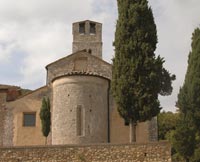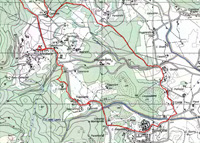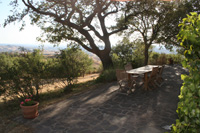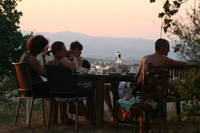Ponte della Pia |
Ponte delle Pia, a medieval bridge that crosses the Rosia stream with a single arch, gives access to the former Augustinian hermitage (eremo) of Santa Lucia (Saint Lucy) at Rosia.
|
|||
Pia de' Tolomei |
|||
"Oh, when you will have come back into the world
|
|||
| Pia's story is the theme of an opera by Donizetti. Dante Gabriel Rossetti painted Pia in 1868.[1] Dante Gabriel Rossetti, Pia de' Tolomei |
|||
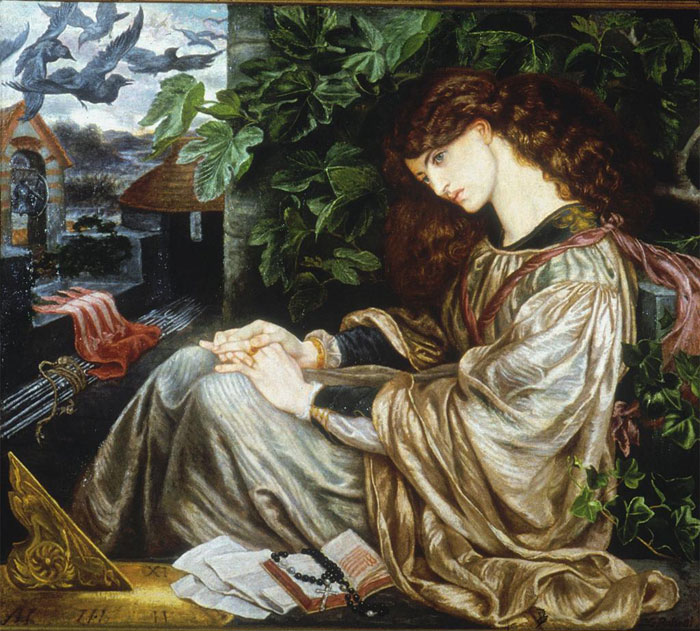 |
|||
Dante Gabriel Rossetti, Pia de' Tolomei (1868–1880) (model: Jane Morris), Spencer Museum of Art, University of Kansas, Lawrence, KS, USA
|
|||
'In La Pia de’ Tolommei, Rossetti creates a character and scene from Dante’s Divine Comedy through the use of symbols. Here, La Pia sits upon the ramparts of the castle. The surrounding foliage alludes to her frustrating and miserable situation. The climbing fig tree framing her face symbolizes fruitfulness, and the sprigs of ivy on lower right corner represent clinging memory or fidelity in marriage. She plays with her wedding ring ("fair jewel") that symbolizes how a once joyous event now represents her unfortunate predicament. The sundial in the lower left corner is a reminder of the passing of time, or the coming of death, and the wheel of fortune motif on it refers to life changes. The rosary lying on an open prayer book refers to her name La Pia, which translates as "The Pious." Old love letters from her husband also symbolize the passing of time. The bundle of lances on the ground serves as a threatening barrier both compositionally and symbolically to the landscape below and her potential freedom. The red and pink banner of her husband draped across them reminds us of her captivity and that her once-beloved husband is now her jailer. Black crows flying above are thought to symbolize verse five of Rossetti’s poem "Sunset Wings" from 1871, about love that changes, never to be relived. The cloudy sky and gray barren landscape create a grim setting to this sad tale. La Pia’s contemplative expression is one of melancholy and introspection. Rossetti often designed the frames to enhance the subject matter. On the frame for La Pia, he engraved the passage from the poem in both Italian and English in which La Pia’s spirit speaks to Dante: "Remember me who am La Pia- me
FromSiena, sprung and by Maremma dead. This in his inmost heart well knoweth he With whose fair jewel I was ringed and wed." The model for this painting is Jane Morris, wife of William Morris, a fellow artist and good friend of Rossetti. This is especially meaningful because Rossetti was in love with Jane Morris. He uses this passage from Purgatory to express his own unhappy romantic experiences with a woman who is married to, and in a sense, prisoner of a man she does not love.'[2] Dante Gabriel Rossetti, Giotto Painting the Portrait of Dante, 1852
|
|||
| This is the drawing Dante Gabriel Rossetti made in 1852 preliminary to the watercolour of the same year (the latter now untraced). Rosetti intended to do a painting on the subject but never did. Giotto's original picture 'a fresco celebrating the glory of Florence' included the figure of Dante holding a pomegranate. It was painted sometime between 1290-1300 on the altar wall of the Palace of the Podesta (later the Bargello) in Florence, but was subsequently covered with whitewash. It was rediscovered in 1840. Seymour Kirkup, one of the scholars who made the discovery, made a copy of the portrait of Dante and sent it to Gabriele Rossetti, from whom it passed to Rosetti. Giotto is painting the portrait of Dante on a chapel wall, while Beatrice moves below in a procession of women. Cimabue is on the right. Six lines of Italian verse from Dante's Purgatorio, followed by the two opening lines of a sonnet from the Vita Nuova, are inscribed below the drawing. “Credete Cimabue nella pintura Tener lo campo; ed ora ha Giotto il grido, Sì che la fama di colui s'oscura. Così ha tolto l'uno all'altro Guido La gloria della lingua; e forse è nato Chi l'uno e l'altro caccierà di nido.” Vede perfettamente ogni salute Chi la mia donna—tra le donne—vede. According to Dante Gabriel Rossetti, the picture “illustrates a passage in the Purgatorio [XI. 94-99] where Dante speaks of Cimabue, Giotto, the two Guidos (Guinicelli and Cavalcanti. . .) and, by implication, himself. For the introduction of Beatrice, who with the other women. . .are making a procession through the church, I quote a passage from the Vita Nuova [XXVI: Sonnet: For certain he hath seen all perfectness]” (see Rossetti's letter to Thomas Woolner, 1 January 1853, Fredeman, Correspondence, 53. 1). Rossetti made a translation of the passage from Dante. The picture was to have been the first in a Dantescan triptych. The other two panels of the triptych would have shown Dante as a Florentine magistrate sentencing Cavalcanti to exile, and Dante at the court of Can Grande della Scala. A complex set of historical circumstances invest this picture. Giotto's original picture—a fresco celebrating the glory of Florence—included the figure of Dante holding a pomegranate. It was painted sometime between 1290-1300 on the altar wall of the Palace of the Podesta (later the Bargello) in Florence, but was subsequently covered with whitewash. It was rediscovered in 1840. Seymour Kirkup, one of the scholars who made the discovery, made a copy of the portrait of Dante and sent it to Gabriele Rossetti.[3] Giotto Painting the Portrait of Dante | www.rossettiarchive.org |
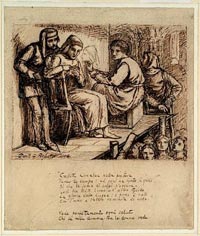 |
||
 |
|||
| Palazzo Tolomei, Siena | |||
[0] Foto di LigaDue, icenziato in base ai termini della licenza Creative Commons Attribuzione-Condividi allo stesso modo 4.0 Internazionale. [1] Source: Traveling in Tuscany | Sovicille [2] Narrative Devices in Art | www.spencerart.ku [3] Giotto Painting the Portrait of Dante, Dante Gabriel Rossetti , 1852 | www.rossettiarchive.org The Rosetti Archive facilitates the scholarly study of Dante Gabriel Rossetti, the painter, designer, writer, and translator who was, according to both John Ruskin and Walter Pater, the most important and original artistic force in the second half of the nineteenth century in Great Britain. In Whistler's famous comment, “He was a king”. Completed in 2008 to the plan laid out in 1993, the Archive provides students and scholars with access to all of DGR's pictorial and textual works and to a large contextual corpus of materials, most drawn from the period when DGR's work first appeared and established its reputation (approximately 1848-1920), but some stretching back to the 14th-century sources of his Italian translations. [3] Photo by licensed under the Creative Commons Attribution-Share Alike 3.0 Unported license. |
|||
| This page uses material from the Wikipedia articles Pia de 'Tolomei, Dante Gabriel Rossetti, and Sistine Chapel, published under the GNU Free Documentation License. | |||
| The Eremo di Rosia is situated near the medieval bridge over the River Rosia, called Ponte della Pia. The church, entitled to holy Antonio and Luca, was probably built with only nave's system but today is remained only the presbytery's and external wall's part. From the main road, the hermitage is located along a cobblestoned Roman road surrounded by woods. During the Middle Ages this road was a spur off the Via Francigena, the route from Canterbury to the holy places in Rome. The hermitage Eremo di Rosia was situated just a little off the road but close enough to be visited by pilgrims. It is cut into the hillside and consisted of a Gothic church, the hermits' convento or friary, places for working and storage, a cloister (clausura) roofed over on two sides and a channel for bringing fresh water to the residents. Like the legends of Lecceto and Centumcelle, Rosia lays claim to a visit from St. Augustine during the year of 387 on his way from Milan to Rome. |
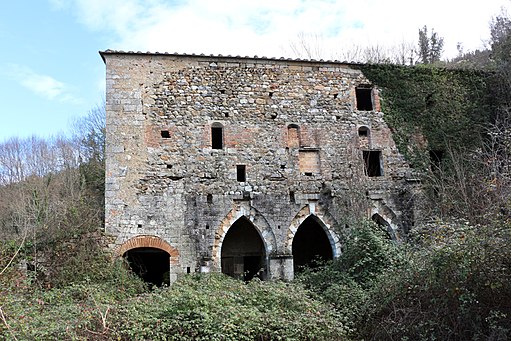 |
||
Eremo di Santa Lucia (Rosia)
|
|||
Castel di Pietro in Gavorrano
|
|||
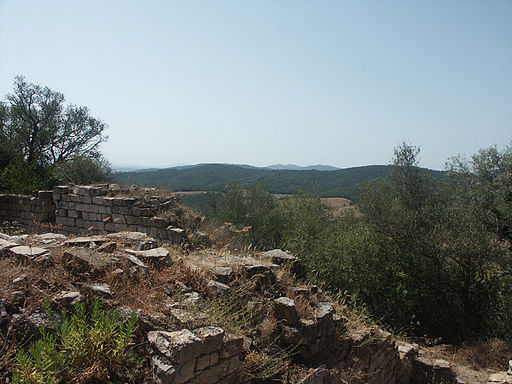 |
|||
Castel di Pietro in Gavorrano, where Pia de Tolomei was pushed to her death
|
|||
|
|||
| Sovicille’s territory stretches from La Montagnola Senese to the valley of the river Merse. |
|||
From Villa di Cetinale to the Pieve di Pernina |
|||
| Leaving from the Renaissance Villa di Cetinale, walking through the green woods we shall climb the Scala Santa up to the Romitorio monk residence. From here we shall see the amazing panorama and then we shall reach the Pieve romanica of Pernina and see the Celsa castle. |
|
||
| Sovicille a land to discover | Itineraries | Ponte della Pia, Eremo di Santa Lucia, Castello di Spannocchia, Monte Acuto, Torri, Rosia |
|||
| Starting from Rosia you take the SP 73 (Provincial road 73) in the direction of Roccastrada and after 2 km. on paved road you arrive at Ponte della Pia – Pia’s Bridge, which you can easily see on your left. You cross the bridge keeping to your right along the cart road which is partly stone flagged and is the antique road to the Maremma region to the west. After about 700 mt. you arrive at a crossroads and you turn to your left (following the indications of a small marker: S. Lucia (St. Lucy’s) The road goes up for about 200 mt. until it arrives in front of the antique Eremo di Santa Lucia –St. Lucy’s Hermitage. tarting from Rosia you take the SP 73 (Provincial road 73) in the direction of Roccastrada and after 2 km. on paved road you arrive at Ponte della Pia – Pia’s Bridge, which you can easily see on your left. You cross the bridge keeping to your right along the cart road which is partly stone flagged and is the antique road to the Maremma region to the west. After about 700 mt. you arrive at a crossroads and you turn to your left (following the indications of a small marker: S. Lucia (St. Lucy’s) The road goes up for about 200 mt. until it arrives in front of the antique Eremo di Santa Lucia –St. Lucy’s Hermitage. of the Rosia plain) you arrive in the hamlet of Torri. Having crossed the town center in 2 km. you go down the paved road and turning left onto the main road you arrive in the town of Rosia. |
|||
|
|
|||
Trekking in Toscana | Monteriggioni – Ponte della Pia Sovicille - Pieve a Molli - Montarrenti - Ponte della Pia | 13 km Anello Sovicille – San Giusto – Villa Cetinale – Pieve di Pernina – Ancaiano – Castello di Celsa | 16 km Anello Sovicille – Villa Cetinale – Pieve di Pernina – Molli | 17 km
|
|
||
Maps: Multigraphic 509 La Montagnola Senese 1:25.000 |
|||
 |
||||
Castel di Pietra, Lapide apposta sulle mura del castello nel 1921 in occasione del VI centenario della morte di Dante Alighieri (Foto: Aerospike)
|
||||
|
||||
Podere Santa Pia |
Podere Santa Pia, terrace
|
|||
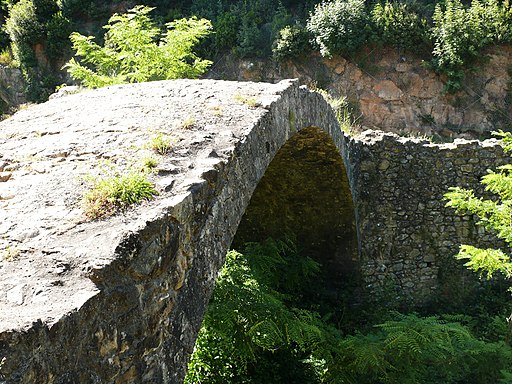 |
 |
 |
||
Ponte della Pia - Molli
|
Ponte della Pia – Monteriggioni | Trekking in the Montagnola Senese
|
||


